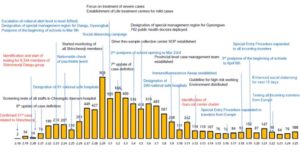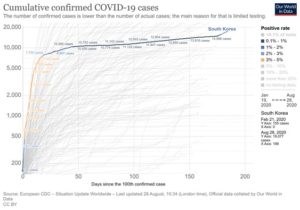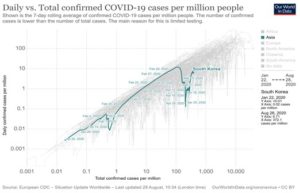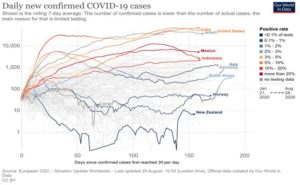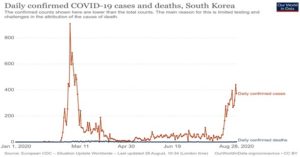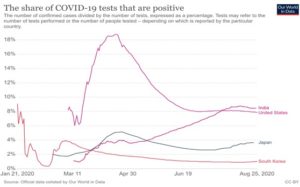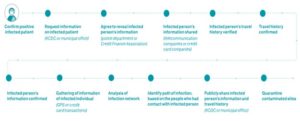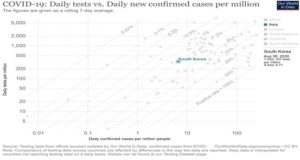Fighting the Pestilence: Lessons from South Korea
Part II: COVID-19 in South Korea
By Gouranga Gopal Das
Incidence of COVID-19 – Past and present
Situated at the strategic heart of East Asia surrounded by China, Russia and Japan, South Korea has emerged as a powerful nation—economically, culturally, and politically—weathering several crises, such as the savage Inter-Korean War (1950-1953), the political crisis of democratization after the assassination of Park Jung-Hee (1979), Asian Economic Crisis (1998), and Global Financial Crisis (2008). It has witnessed remarkable economic development despite these thanks to the wise policymaking in the areas of education, health, trade (import substitution to export promotion); successful land reform; and industrial policies. These have established it as a leading OECD (Organisation for Economic Co-operation and Development) member country with a per capita income of US$ 43,143 in 2020.1 Even with its limited natural resources, absence of highly-educated scientists, engineers, and experts during 1940s due to Japanese colonial occupation, the country has now become a powerhouse of science, technology, and engineering with one of the highest human development index (HDI of 0.903, ranked 22nd).
The five-year plans for economic development starting from 1962 paved the way for the all-round success with rapid industrialization, light and heavy industries, as well as hi-tech products conjointly with the training of scientists and skilled workers. The economy recovered and regained the glory of the ‘Miracle on the Han River’ with an appropriate combination of the exchange rate and other policies to tame the vulnerability even as uncertainty and ambiguities about a unification in the peninsula continued. All these prepared this country to fight hardships. Initially, Korea’s rapid industrial revolution achieved within a span of 30 years (five-year development planning from 1962—1986) was due to the combination of policies like the construction of pyramid type export-oriented industrialization along with modernization plan and inclusiveness via promotion of national living standards, education (Won-Chol 2009). This was followed in subsequent years and laid a strong foundation for overcoming obstacles. This background is essential for understanding the handling of the pandemic-led dual crisis of health and wealth.
The reason why other countries bigger in size and less troubled than Korea did not perform as well as it did is rooted in Korea’s historical trajectories and philosophy of ensuring the progress and welfare of citizens. Let us look at the basic statistics of Korea as it influences the pandemic impact. In 2019, Korea’s population was 51.8 million of which about 9.7 million live in the capital city, Seoul. About 1.8 million are foreigners.2 Net migration was 31,775 in 2019 with the total migration being 1.5 million. The number of incoming foreigners till March 2020, was 18,810 of which China accounts for 5,546 and US accounts for 1,976. Table 2 below presents the vital statistics as well as indicators of economic performances.
Table 2. Basic indicators of selected vital statistics of Korea
| By items | 2017 | 2018 | 2019 | % change from 2018 |
| Live births (persons) | 357,771 | 326,822 | 302,676 | -7.4 |
| Deaths (persons) | 285,534 | 298,820 | 295,110 | -1.2 |
| Crude birth rate (per 1,000 population) | 7.0 | 6.4 | 5.9 | -7.8 |
| Crude death rate (per 1,000 population) | 5.6 | 5.8 | 5.7 | -1.7 |
| Infant mortality rate (per 1,000 live births) | 2.8 | 2.8 | 2.7 | -3.6 |
| Life expectancy at birth-total (age) | 82.7 | 82.7 | – | – |
| Life expectancy at birth-male (age) | 79.7 | 79.7 | – | – |
| Life expectancy at birth-female (age) | 85.7 | 85.7 | – | – |
| Gross domestic product (current prices, dollar) (M U$) | 16,233.10 | 17,251.60 | 16463.3 | -4.6 |
| Per capita GDP (current prices, dollar) (U$) | 31605.2 | 33,429.00 | 31,838.20 | -4.8 |
| Gross national income (current prices, dollar) (M U$) | 16,299.20 | 17,321.10 | 16,606.30 | -4.1 |
| Per capita GNI (current prices, dollar) (U$) | 31,734.10 | 33,563.70 | 32,114.90 | -4.3 |
Source: Statistics Korea. http://kosis.kr/eng/ Vital statistics
From Table 2, it is evident that in Korea all other causes of death, viz., from malnutrition, diabetes, respiratory diseases, influenza, and pneumonia, etc. have registered a sharp fall from 2018 to 2019 and there is only a small (i.e., 3%) positive change in death due to ‘certain infectious and parasitic diseases’. This may be related to several factors, such as health expenditure as percentage of GDP (8.1% in 2018 as compared to OECD average of 8.8% and higher than 3.6% of India)3 and social welfare expenditure—see Table 3 below.
Table 3. Basic indicators of ‘causes of death’ in South Korea
| By the cause of death (103 items) | 2018 original data | 2019 original data | Percent change from 2018 |
| Certain infectious and parasitic diseases (A00-B99) | 1,308 | 1,347 | 3.0 |
| Endocrine, nutritional and metabolic diseases (E00-E88) | 1,890 | 1,730 | -8.5 |
| Diabetes mellitus (E10-E14) | 1,511 | 1,376 | -8.9 |
| Malnutrition (E40-E46) | 28 | 17 | -39.3 |
| Diseases of the respiratory system (J00-J98, U04) | 2,489 | 2,265 | -9.0 |
| Influenza (J09-J11) | 55 | 40 | -27.3 |
| Pneumonia (J12-J18) | 1,446 | 1,294 | -10.5 |
| Other acute lower respiratory infections (J20-J22, U04) | 1 | 1 | 0.0 |
| Chronic lower respiratory diseases (J40-J47) | 377 | 337 | -10.6 |
| External causes of morbidity and mortality (V01-Y89) | 15,987 | 15,592 | -2.5 |
Source: KOSIS. Statistics Korea, Causes of Death Statistics
The table signifies that as Korea has already minimized the death from other debilitating and co-morbidity factors, due to its historically solid investment on basic health and human capital indicators. The impact of the pandemic will have a lesser impact because the ‘basic preconditions’ have enabled the country to come up with counter-measures and appropriate steps without worrying about primary health conditions of the citizens. In other words, the success story of Korea in tackling the current health crisis is deep-rooted in its economic development plans since the 1960s. According to OECD (2018) health statistics, although government expenditure share (59.8%) in current health expenditure is low compared to the OECD average (73.8%), it increased by 0.9 percentage point while private medical expenditure reduced by 0.8 percent. Overall, health expenditure increased from 7.7 percent to 8.1 percent of GDP.
The pandemic hit Korea very hard and by the middle of February, it reached its peak, and was second, after China in its spread. Cluster infections kept increasing, spreading through Church congregations, fitness clubs or gyms, night clubs or ‘singing places’, sauna, and warehouses. By March, it increased rapidly but about 230,000 people were tested (thrice the numbers in Italy and 20 times in the US) (See Choi 2020). Figure 3 is from GROK (May 2020) showing the unfolding of events related to COVID-19 and the measures taken. As per this report (page 4, ibid.): ‘ Korea was able to successfully flatten the curve of COVID-19 in only 20 days without a complete lockdown, which has had a huge impact on the global economy, by maintaining a balance between quarantine and social distancing on one hand and continuing with economic activities and production on the other.’
Table 4. Indicators of social welfare expenditure ratio (of GDP)
| By financial resources and function (1) | By financial resources and function (2) | 2015 | 2016 p) | |
| Original Data | Original Data | % change from 2015 | ||
| By financial resources | Sub Summary | 11.20 | 11.50 | 2.7 |
| Public expenditure | 10.20 | 10.50 | 2.9 | |
| Legal private expenditure | 1.00 | 1.00 | 0.0 | |
| By Function | Sub Summary | 11.20 | 11.50 | 2.7 |
| Old age | 3.50 | 3.50 | 0.0 | |
| Survivors | 0.30 | 0.30 | 0.0 | |
| Incapacity-related benefits | 0.60 | 0.60 | 0.0 | |
| Health | 4.20 | 4.30 | 2.4 | |
| Family | 1.20 | 1.30 | 8.3 | |
| Active labour market programmes | 0.40 | 0.40 | 0.0 | |
| Unemployment | 0.30 | 0.30 | 0.0 | |
| Housing | 0.00 | 0.10 | ||
| Other social policy areas | 0.70 | 0.70 | 0.0 | |
Source: Ministry of Health and Welfare, Social Expenditure in Korea
Figure 3. Unfolding of events related to COVID-19
Thus, we see in Figure 4 that S Korea has flattened the curve long before other countries, not to mention even about India.
Figure 4. Cumulative confirmed COVID-19 cases
South Korea’s second pike: New measures for resurgence control
Korea had a second spike sometime in August as we see from Figures 5 and 6 below.
Figure 5. Daily vs. total cases per million
Figure 6. Daily new, confirmed cases
However, the chart shows that S Korean cases were still way below those in India, Brazil, Mexico, Italy, the UK, and the US. The flattening of the curve is attributed to the ‘3T (testing, tracing, and treatment)’ strategy and adoption of measures facilitating the spread of digitization using ICT and other associated technological breakthroughs (see the next sections). Moreover, despite these rising trends, the death rate was still quite low (see Figure 7 below).
Figure 7. Daily confirmed cases and deaths
However, as Figure 8 shows even with the second spike, confirmed cases were significantly lower when compared to its own first stage and to other countries. In the first phase, till March, it was higher than in some ‘exemplar’ countries like Taiwan, Japan, New Zealand, but S Korea immediately garnered efforts to control the situation.4
Figure 8. Share of positive cases
Role of innovative public health management and timeliness
3T strategy
South Korea created a global ‘gold’ standard for ‘trace, test and treat’ – the 3T model for fighting COVID-19 from the beginning, which was effective in saving lives while the developed nations—presumably having sophisticated medical systems but with debates on effective health insurance systems—limped.5 Even CNN’s flagship coverage of COVID-19 mentioned it as a ‘public health success story’.6
The capacity to test was reported to be about 140,000 samples per week. In March, 274,000 people have been tested with the overall rate of 5,250 tests per million people. As the New York Times (NYT) reported during that time—it already reduced to 50 per day from a ‘peak of 813 on Feb. 29, [2020].’ Seventy percent of 10,400 confirmed cases were tested, treated, and confirmed recovered and sent back home. ‘Nearly 20,000 people are being tested every day for coronavirus in South Korea, more people per capita than anywhere else in the world’, the BBC report mentioned.
Flow chart 1 offers a cogent picture of the efficacies of the 3T strategy. According to Choi (2020), all these – testing on a massive scale, diagnosis, kits distribution, swab culture, PCR tests – were possible due to another enabling factor, viz., employment of 2,000 young Public Health Doctors (PHDs) to work in urban, rural and remote areas; or even in quarantine facilities in airports, correctional centres for three years in lieu of their mandatory military services in national interest.
Using Polymerase Chain Reaction (PCR) testing the fatality rate roughly estimated was 0.7 percent while the global average was 3.4 percent or above. Compared to Korea’s aggressive testing strategy, Italy stood second with 2,200 tests conducted per million people, while Australia recorded at 1,900 per million people and in the US, this was 125 people per million. This is remarkable as the first case of COVID-19 in S Korea was confirmed on January 20, 2020. About 8,000 people were suspected of infection in a month’s time mainly due to the defiance of social rules by the religious cult, Shincheonji, with more than 200, 000 members. The cases soared to 82,000 by February and this had been the largest spike outside of China. But the image of the state remained as one of ‘welfare state’ and an ‘emancipating state’ saving lives willingly, aiding and assisting those less capable ones. The most significant thing that attracted global attention is that despite the onslaught of the coronavirus in April, it held ‘democratic elections’, which is not only impossible in developing economies like India, but also in other developed states with properly functioning democracy.7
Flow chart 1
This is reflected in the positive correlation – as depicted in Figure 9 below – between cases and tests (as of writing this piece) even after the second spike without any laxity or sense of complacency. Given that S Korea is a democracy, there are criticism and protest by the opposition but the strong-handed measures by a benevolent government have set the path for successful combat of Sars-Cov2-virus. This developed into a ‘can-do’ spirit and optimism for not only public health but also for the health of the economy while India is working as a limping tiger fearing extinction. This extraordinary scale and speed of S Korea’s screening system have been applauded globally as a role model for other countries and conceived as the most effective ones (Lee, Heo and Seo 2020). As these authors mention, without ‘lockdown or shutdown’ measures, ‘combining testing, early isolation, and free treatment of positive cases combined with digital technologies’ helped in flattening the curve.
Figure 9. Daily tests vs. daily confirmed cases
Attitudinal changes The ‘transparency’ by holding press briefings twice a day with disclosure of all pertinent information garnered great public confidence in the truest sense of the term. This, in turn, facilitated ‘civic participation and voluntary engagements of citizen and businesses. In fact, a study by Aum, Lee and Shin (April 27, 2020) shows that if the UK had adopted the S Korean policy of ‘3T’ by tracking and testing with prompt actions, without less stringent lockdown, the loss of GDP and productivity due to infection spread and fear would have been much less. Another study (Belot et al. May 8, 2020) surveying households with different age and occupational compositions observes that different behavioural nudges (like using online platforms, maintaining social distancing, wearing masks, healthy habits, etc.) worked in tandem with national-level policy restrictions despite heterogeneities across samples and members. The following Chart 2 shows such behavioural changes.
Chart 2. Behavioural patterns - China, Japan, Korea
Source: Belot et al. (May 8, 2020)
According to a study of 25 US states and 23 countries, by Atkeson, Kopecky, and Zha (August 2020), non-pharmaceutical interventions (NPI) are effective as long as transmission rates are high but with reduced social and economic interactions the role of NPI is not that effective to cause a decline in transmission. This means that other factors, such as voluntary social distancing, technological infrastructure, and public confidence in the government are crucial. In case of densely populated Hong Kong with over eight million citizens, the role of civil society and ‘social mobilization’ was instrumental on top of the government’s effectiveness for stopping the surge and transmission (Wan et al. 2020).
The success of any country in controlling the spread of COVID-19 hinges on its ability to gain maximum resilience. For that, the government needs to mobilize utmost efforts for superior crisis management structure ensuring public health and safety, which, in turn, depends on accelerated digitization, reorganization of economic structure, and adaptability to face the ‘new’ normal with revamped strategies. Over the years, cumulative strength culminated in S Korea’s exemplary performance in managing the deadly coronavirus at a rapid pace beating almost all nations in their efforts. Readiness, Reassurance, and Rapidness were three R’s that drove President Moon Jae-in to drive the revival.
So although, the outbreak of the Middle East respiratory syndrome (MERS) in 2015, enabled S Korea to introduce a system for undertaking testing efficiently. One of the important elements is the behavioural aspect. In fact, ‘nudging’ the behaviour of mask-wearing had great success in East Asia even prior to COVID-19 for pollution-led respiratory disease prevention. It has been found out that mask-adoption led to less shutdown with less economic impact (The Economist, 30 May 2020). Thus, the lockdown was not so effective with NPI unless other remedial steps are adopted. The inverse relationship between the degree of shutdown and mask-wearing has been validated by contact tracing and testing.
Effective use of technology
Even as the US and other European nations cited their success story with great aplomb, S Korea stands apart amongst all nations fighting this deadly pathogen. That was possible because of historically rooted development plans based on health and education and supporting national innovation systems. Flattening the curve was achieved through judicious use of technology, GPS, big data, medical technology, people’s trust and the government’s proactive approach. Now, when it has spread across 196 countries and territories are being put under lockdowns, S Korea is able to manage without imposing draconian restrictions. Prompt action, agile healthcare workers, developing test kits at affordable prices, tracing contacts, individual-level health surveys, and critical support, civic sense all worked simultaneously. The WHO and leaders of other countries, impressed with this timely response, consider the S Korean experience as a role model to emulate.
In a study, S Korean’s success is attributed to several factors, such as epidemiological investigations, centralized governance to monitor and regulate the outbreak, and flexible financial management are primary factors along with the measured quarantine procedure without paralytic effect on the economy and with a supportive national health system.8 Government websites and mobile apps disclosed how many people had been tested and where. The report particularly mentions research (by Researcher Yoo Jong-eun) conducted at the University of Colorado that mentions the widespread use of real-time ‘reverse transcription-polymerase chain reaction (RT-PCR) diagnostic method’ for conducting tests in 600 centres with 71 drive-through clinics at more than 90 medical institutions. Drive-through stations were set up, where members of the general public could be tested in minutes. It saw a jump in diagnostic tests from 522,000 people in March to 534,552 in April.9 The article specifically mentions that the core elements of S Korea’s response strategy were: (i) public health administration and the country-wide infectious disease management plan, (ii) cooperation with the private sector, (iii) strict contact tracking (tracing), (iv) flexible medical systems, and government-led communication, (v) actively identifying patients with COVID-19 and disclosing results of epidemiological investigations on confirmed patients to the public, providing differentiated treatment according to the severity of symptoms, (vi) a rigorous and extensive epidemiological investigation on cases of COVID-19 patients, which included (vii) a variety of information data, such as interviews with patients, medical records, credit card records, and satellite positioning system (GNSS). Although S Koreans have a tendency to take some degree of invasion of privacy, such as personal information for public health purposes, they cooperated with the government for much-broader objectives of societal well-being. Expanding administrative procedures for the public health system and good governance, plus financial support from a generous health budget at this critical juncture were very effective. Even foreign nationals in need of treatment under quarantine were taken care of with additional budgetary adjustments. Kim, Seo and Yeom (2020) estimated the Susceptible-Infected-Removed (SIR) model with counterfactual scenarios in simulations to show that without the public health interventions, the transmission rate would have been as high as 2,5000, 000 (breakpoint) compared to 8,000 as observed on March 7, 2020.
As mentioned earlier, counterattacking the disease needs a new arsenal of strategy utilizing the power of globalization, innovation, and digitization with proper government intervention (Das 2020a&b). A three-tier policy embracing three main pillars or themes of data infrastructure, ‘untact’ (contactless) services, and the digitalization of social overhead capital (SOC), or mainly government provided capital goods available for all were instrumental for the successful efforts. In order to make them work, the government selected 10 large projects – expansion of data infrastructure in six key sectors (finance, health, transportation, public service, industry, and small- and medium-sized enterprises), support for greater use of AI, integration of 5G networks, development of platforms for remote services, digitalization of public infrastructure (for example, installing IoT sensors on roads for collecting traffic data), and others.
Several areas, in healthcare and economy, can be highlighted, such as (1) emergence of the ‘Untact’ or ‘Ontact’ economy (the words originate from Undo and Contact, and Online plus contact)10; (2) new technology and its usage; (3) entrepreneurship and capability; (4) extensive use of QR code everywhere – offices, organizations, and universities; (5) fiscal stimulus with zero-lockdown strategy; (6) second wave and level-3 security; (7) triage; (8) contract tracing. There was a ‘drone’ awareness campaign in July to raise consciousness among citizens on social distancing, sanitizing, and health management. The study by Huang et al (April 15, 2020) mentions that type of regimes—authoritarianism versus democracy—are less important as Korean experience of ‘flattening the curve and handling the sporadic outbreak on the second occasion has shown that cocktails of health, education, economic, and technology policies worked with much-acclaimed performance. The S Korean Government (2020) has documented the effort.11
The pandemic in S Korea has paved widespread adoption of digital services – spanning online streaming to work from home. Untact for promoting ‘contactless digital services’ includes fintech, e-commerce, and/or remote work platforms, and has evolved as a key growth-enhancer for economic activities in S Korea. Also, Kakao (the Korean equivalent of WhatsApp and Viber) has registered net profit rise by 180 percent. Also, online sales, in general, have increased by 41 percent as compared to previous years. This kind of digitization-enhanced activities nudged a broader shift in behavioural attitude towards these services, speeding-up the momentum for a nationwide positive response to digitalization.
Vaccine research
In a report by Sakellaropoulou (June 4, 2020), it was mentioned that the ‘role that science, cooperation, transparency, data and information sharing have in informing government policies and shaping one of the most successful COVID-19 responses globally so far, led by South Korea’. The article, based on S Korea’s leading research institutes, such as Centre for Convergent Research of
Emerging Virus Infection’(CEVI), Korea Research Institute of Chemical Technology (KRICT), and Korea Institute of Science and Technology (KIST) documented the role of multidisciplinary, multi-institutional specialized research work on diagnosis, vaccine, and disease spread simulation studies for quick testing and identifying patients with antibodies, and sensors for tracing patients, and even for herd immunity.12 In brief, here I present some of the initiatives of the medical firms/sectors in their endeavour for vaccine research. This will give us some idea about continued research efforts towards warding off the pestilence. However, detailed information about clinical trials for COVID-19 vaccines and therapeutic drugs are available on the Korea Food and Drug Administration and Korea clinical trial portals. Three medium-sized pharmaceutical companies, Ilyang Pharmaceutical, Bukwang, and Shinpung, along with the large ones, GC Gree Cross, Daewoong Pharm, and Chong Kun Dang, have undertaken efforts to produce chloroquine, Pyramax, and Calletra for non-targeted treatment. However, these companies experienced mixed fortunes because of different feedbacks on these drugs mainly used in treatments of malaria or HIV.13
In a recent media report titled, Korean drug makers ‘virtualizing’ COVID-19 studies, it has been mentioned that the leading Korean biopharmaceutical companies took recourse to ‘cloud platform’ of Medidata—a leading company also used for Moderna’s mRNA-1273 in the US for one of its largest clinical trials – for ‘testing’ their treatment effects and vaccine clinical trials.14 As it is a ‘new paradigm’ of medical research for developing new medicines, this will enable S Korea to integrate its technological competencies, research tools, advance medical research, with big data on patients’ cases, and clinical trials in a global standard for the best outcome for society during this pandemic. Bioneer is a leading company situated in the Science City of Daejeon in S Korea which is leading the research on the vaccine and COVID-19 treatment.15 Recently, it has developed an ‘in vitro’ diagnostic kit ‘AcuPower RV1 Multiplex’ for diagnosis of influenza and COVID-19 infections by the detection of five targets related to SARS-Cov2-19 virus in a tube. It is a new innovation that could pay in the long run. In fact, ICMR (Indian Council of Medical Research) in India has got three different kinds of kits from Bioneer, BioSewoom, GeneMatrix, iNtRON Biotechnology Inc (Loften India Pvt Ltd.), Kogene Biotech, LabGenomics (Siemens Healthcare Private Limited), Micobiomed Co. Ltd, Seegene, SD Biosensor, etc., to name a few.
Use of cutting-edge technology
It is imperative to see the role of public policy for harnessing new technology so that the world reconnects—with immense irreversible benefits—and eliminates the adverse impacts of ‘social distancing’ despite being ‘obsequious’. Without being panglossian, we can easily offer evidences of such effectiveness of new technology (Das 2020 a, b & c). The efficacy of 3Ts along with judicious quarantine measures, and prior experience in handling SARS in 2003 and MERS in 2015, as mentioned by Park et al. (2020), was quite effective because of the revisions of the Contagious Disease Prevention and Control Act (CDPCA) in keeping with the need of the hour to collect personal information for epidemiological investigation. As Park et al. (2020) mention, ‘the epidemiological investigation system is equipped with a double login system through a private network to prevent hacking and all log-in data remains in systems.’
Recently, Korea Advanced Institute of Science and Technology (KAIST)—S Korea’s top-most world ranking academic institution (96th World Ranking for 2020-2021 and 2nd in the country)16 – developed a model system for this contract tracing with private information protection without privacy breach. This is called, ‘Prevention System for Pandemic Disease Infection (PreSPI) based on a smartphone’s black box that can help individuals get the COVID-19 test, trace their contacts, and treat the disease.’ The KAIST said, ‘As the PreSPI used a black box of a smartphone to regularly collect and record signals coming from the global positioning system (GPS), wireless local area network (LAN), Bluetooth, barometer, and inertial sensors. It can minimize the risk of privacy infringement.’
The previous system, used for the disclosure of COVID-19 patients’ movement routes, came under fire because it extensively accessed to personal information such as credit card usage. The Epidemiologic Investigation System shows signals recorded on a COVID-19 patient’s smartphone on a map, which can help an epidemiological investigator identify the movements. This system uses the KAIST Locating System (KAILOS), an indoor/outdoor integrated location tracker developed by Han for over a decade, to identify the movements of a confirmed patient even inside a building. The Isolated Person Management System analyses signals collected by a smartphone’s black box in real-time to check whether the patient is out of the isolated zone. It uses both GPS and wireless LAN signals to check whether the patient is out of a room, as well as out of a building.’17
Figure 10. PRESPI technology and its functioning
Source: Korea Biomedical Review
The idea of ‘Patient Equation’ and this one, are just two of many such uses of cutting-edge technology in combating COVID-19 in S Korea. With regard to education and technology, S Korean policy is worth mentioning. Given the pandemic-induced shocks in education in developing countries, there might be an aggravation of the existing gap between the rich and the poor; the digital divide. For example, without technology and associated infrastructure, it is hard to keep up with the quality education at primary, secondary and tertiary levels. For example, in the case of India, despite ICT-enabled services public health and education is suffering immensely. How will that be addressed? Blended learning in S Korea is very effective. Most importantly, when social contact and contract are rationed during the COVID-19 pandemic, the social benefits of ICT are being realized with possibly no gaps even among the rural poor.
Role of Korean economic policy
The pandemic has triggered a slowing down of economic activities culminating into a global recession. South Korea’s post-COVID economic policy is a laudable, state-initiated strategy for a post-COVID economy. On May 7, 2020, S Korea responded to this crisis by injecting cash into the economy for undertaking a series of policy measures designed to support post-COVID economic recovery. The New Deal – an extension of the previous efforts of ‘inclusive policy’ framework for the next five years – announced shoring up of 11.7 trillion won via dual-track COVID-19-specific supplemental budget measures. Subsequently, a third one was proposed in early June to support the initial stages of the Korean New Deal, committing to spend 76 trillion won until 2025. On June 1, the government announced a commitment to spending about 31.3 trillion won until 2022, and an additional 45 trillion won until 2025 for the Korean New Deal. Quite clearly, these policies have a long-term goal and endeavour to leverage the COVID-19 crisis to further bolster the social safety net as well as the innovation policies linked with the digitalization policy. South Korea’s four-pronged strategy—encompassing structural reform, building an infrastructure for sustainable growth, strengthening social safety nets and reducing the country’s dependence on the current global value chain—is a vision for not only averting the COVID crisis, but also to avoid the fear of the unknown till the time the vaccine is not developed.
From the aggregate economic indicators shown in figures 12 and 13 below, we see that compared to S Korea, India faces a deep downturn and a difficult recovery. At the time of writing this report, IMF forecast in World Economic Outlook is that India would be the third poorest country in South Asia with per capita GDP shrinking by a further 10.9 percent by 2021 (it declined by 23.9% during the April to June quarter) while Bangladesh will grow by 3.8 percent ($1,888 compared to India’s projected $1,877).18 In S Korea, by March, at the peak of the first phase, around 1.6 million workers were furloughed due to shut-down or slowing demand; 467,000 suffered from job losses; 830,000 faced underemployment with the rate of unemployment at 15 percent; youth unemployment rate rose to 9.3 percent and many are facing the threat of unemployment or working in menial jobs. Not only that, pay cuts are also common. S Korea was already suffering from export fallback due to trade conflicts and minimum wage-related turmoil.
Figure 11. South Korea’s GDP and Gross National Income over 2015-2020
Source: KDI Major Indicators of the Korean Economy, October 2020.
Government response to this precarious situation was a fiscal stimulus package of 270 trillion won (14% of GDP, worth US$ 232 billion) and cutting down of borrowing rates. It rolled out a ‘basic anti-disaster income’ or relief package with targeted vouchers of 400,000—1000, 000 Korean won (US$350-$900) for 67 percent of families. Also, a month later, ‘Emergency Disaster Relief Funds for Foreign Residents in Seoul’ was rolled out to help low-middle income foreign residents.19 The projection by the IMF is a contraction of the world economy by -3 percent while the ASEAN five (Indonesia, Malaysia, Philippines, Singapore, and Thailand) will contract by -0.6percent in 2020. Thus, the damage induced by the pandemic wreaked havoc for countries like S Korea as well.
Figure 12. GDP and Gross National Income of BRICs over 2015-2020
Source: KDI Major Indicators of the Korean Economy, October 2020.
As per Jeong (2020), the factors underlying S Korea’s ‘dexterity’ in showing resilience is due to its formula of ‘heavy on stimulus, light on lockdowns’. South Korean economy suffered from one or more damaging effects and the economic stimulus is not an isolated effort. With additional waves of outbreaks, such as the second spike, a leading think-tank, Korea Development Institute (KDI) projected further contraction by 1.6 percent and a downturn in economic activities. Given its heavy dependence on exports, the challenges in the post-COVID world are enormous. As mentioned before, the Korean New Deal covered by the three pillars were based on the foundation of previous policies for efforts to strengthen the social safety net by expanding employment insurance and training for the future, digitalization that should be addressed in tandem with the new policy to ensure equity and inclusivity. Overall, the Korean New Deal brings together crucial national priorities. It is an example of a successful post-COVID recovery policy. It could be a case study for new national policies in the post-COVID world for many developing economies to ward off the same challenges that S Korea tackled wisely.
AUTHOR
Gouranga Gopal Das, Professor of Economics, Hanyang University, Seoul and Erica Campus, South Korea
This is Part II of a three-part piece.
Part I: A Multidimensional Crisis
Part III: India, Korea and the Kerala Model: Unequal Comparison?


